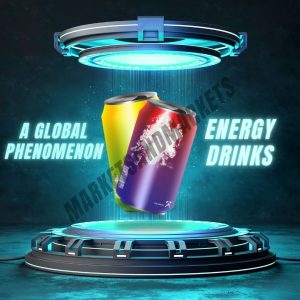The rising consumer demand for convenient and healthy energy boosters is expected to drive exponential growth in the global energy drinks market in the coming years. The industry is anticipated to achieve a significant CAGR.
Energy Drinks: A Global Phenomenon
Formulated with stimulants like caffeine, guarana, taurine, and B vitamins, energy drinks, a type of non-alcoholic beverage, aim to enhance physical and mental alertness. They have become a global phenomenon, particularly popular among young adults, athletes, and professionals seeking an energy boost.
Request more Info: Click here
Market Segmentation: A Deep Dive
The global energy drinks market can be segmented as below:
-
Type:
- Traditional Energy Drinks: These are the most common type, containing high levels of caffeine and other stimulants.
- Sugar-Free Energy Drinks: These cater to health-conscious consumers who seek the benefits of energy drinks without the added sugar.
- Natural Energy Drinks: Unlike some energy drinks that rely on artificial ingredients, these are formulated with natural ingredients like guarana and green tea extract. This appeals to consumers seeking a more natural alternative.
- Functional Energy Drinks: These are fortified with additional functional ingredients like vitamins, minerals, and antioxidants, targeting specific consumer needs like improved focus or enhanced athletic performance.
-
Application:
- Sports Nutrition: Sports Energy drinks are widely consumed by athletes for pre-workout energy boosts and improved endurance.
- On-The-Go Energy: Busy professionals and students often rely on energy drinks for a quick pick-me-up throughout the day.
- Nightlife: Energy drinks are a popular mixer in bars and clubs, often consumed to maintain energy levels during late-night outings.
-
Region:
- North America: The largest consumer of energy drinks globally, dominated by established brands like Red Bull and Monster Energy, with a strong focus on marketing and brand partnerships.
- Europe: A significant market with a growing preference for sugar-free and natural energy drinks.
- Asia Pacific: The fastest-growing region, fueled by rising disposable income and increasing urbanization.
- Middle East & Africa: An emerging market with increasing brand awareness and growing demand for functional energy drinks.
Request more Info: Click here

Statistics & Facts Highlighting Market Growth
- Global energy drink consumption is estimated to be around XX liters per year.
- The average energy drink consumer drinks XX cans per week.
- The 18-34 age group is the primary consumer demographic for energy drinks.
- The market for sugar-free energy drinks is expected to grow at the fastest rate due to increasing health consciousness.
- The demand for functional energy drinks with added benefits is on the rise, catering to specific consumer needs.
Regional Market Landscape: A Closer Look
- Europe: A more fragmented market with a growing preference for private label brands and regional players. Stringent regulations on caffeine content are a key factor.
- Asia Pacific: Rapidly growing market with a diverse range of local and international brands. China, Japan, and India are the key markets in this region.
- Latin America: Brazil and Mexico are the leading markets, with a strong preference for flavored energy drinks.
Industrial Aspects: Key Players and Trends
The global energy drinks market is dominated by few major players, including Red Bull, Monster Beverage, PepsiCo, and Coca-Cola. However, there is a growing presence of regional and private label brands, particularly in Europe and Asia Pacific.
Key trends shaping the Energy Drinks Industry include:
- Product Innovation: Manufacturers are constantly innovating with new flavors, ingredients, and functionalities to cater to evolving consumer preferences.
- Focus on Natural Ingredients: Consumers are increasingly seeking energy drinks made with natural ingredients and less sugar.
- Functional Benefits: Energy drinks are being fortified with additional functional ingredients to appeal to health-conscious consumers.
- Sustainability: There is a growing focus on sustainable packaging and sourcing practices within the industry.
- Regulatory Landscape: Regulations on caffeine content and other ingredients vary by region, impacting product development and marketing strategies.
The Road Ahead: A Promising Future for Energy Drinks
The global energy drinks market is expected to continue its strong growth trajectory in the coming years. Rising disposable income, increasing urbanization, and a busy lifestyle are key factors.
Request more info Click Here
